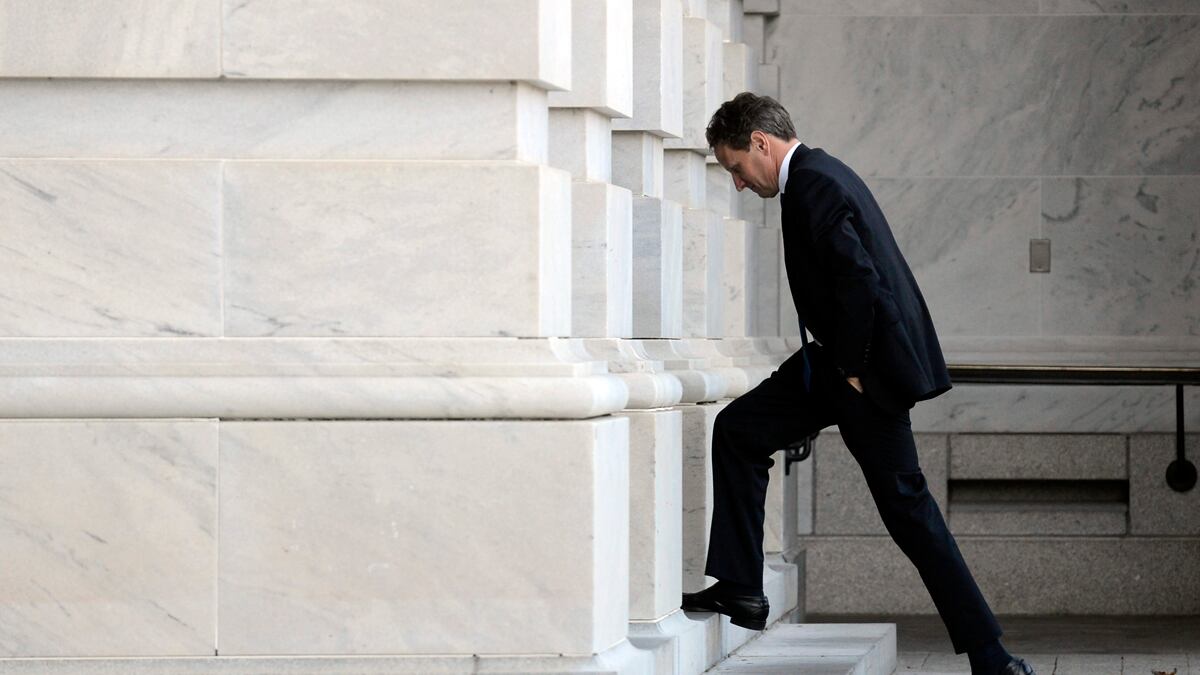On Wednesday, New York Congressman Jerrold Nadler, a Democrat, told Capital New York that although the idea “sounds silly,” it was worth considering, because “when you’re faced with blackmail to destroy the country’s economy, you have to consider things.”
Today, Bloomberg TV also devoted five minutes discussing the idea with Business Insider’s Joe Weisenthal, one of the most ardent defenders of the platinum-coin solution. There’s also a petition on the White House’s We the People site to “Direct the United States Mint to make a single platinum trillion dollar coin!” The petition has garnered more than 1,818 signatures, leaving it 23,182 short of the 25,000 necessary for the White House to formally respond.
Wondering how this would work? If it’s legal? Just read on.

Tim Geithner shows up at the neo-Florentine fortress that houses the Federal Reserve Bank of New York and asks to make a deposit on behalf of the U.S. Treasury. But instead of handing over a check—or the Treasury wiring one over—he unveils a single coin to be deposited. It is worth ... $1 trillion. And with that, the debt-ceiling standoff would be resolved. Instead of issuing debt in the form of Treasury bonds to fund the gap between taxes and spending, the trillion-dollar coin would cover the deficit, and Congress wouldn’t have to worry about raising the debt ceiling, at least for a while. But there must be something wrong with with this scenario, right?
“I love the platinum-coin idea. If I were Secretary Geithner, that’s what I would do. I would prefer to strike a deal, of course, but it’s all just silliness,” says Joe Gagnon, who used to be an economist at the Federal Reserve and is now a senior fellow at the Peterson Institute for International Economics. Although it’s the Federal Reserve that has the power over printing dollar bills (and the electronic money in the form of bank reserves it uses to execute monetary policy), the Treasury, through a weird kink in the law, has the authority to strike a platinum coin of any value).
As of the Treasury’s most recent report on the national debt, the debt that counts toward the statutory-debt limit stands at $16.327 trillion, “just” $67 billion short of the statutory $16.394 trillion debt limit, which it is estimated to hit in February. And with no raise in the debt ceiling looking particularly likely, some are clamoring for perhaps the most clever of all the creative ways for the federal government to skirt the limit: the platinum-coin option (which may or may not have been inspired by an episode of The Simpsons).
Although, as the Washington Post’s Brad Plumer reports, it’s highly unlikely that the Obama administration will go down this road, the fact that some serious people are at least willing to talk to journalists about striking a large-denomination coin to give the government some space from the debt limit puts into stark relief the somewhat strange limits the government puts on itself when it comes to spending and borrowing money.
The way Gagnon explains it, the platinum-coin option holds particular appeal because of how few distortionary effects it would have. Unlike, say, the president simply ignoring the debt ceiling, the platinum-coin option might not provoke a nasty constitutional fight. The platinum coin would, instead, merely allow the federal government to make good on money Congress has already instructed the federal government to spend.
When the government has a gap between its annual expenditures and the revenue it takes in from taxes and other sources, it covers the difference by issuing debt. The statutory debt limit caps the amount of outstanding debt the government can have, and so has been raised more than 70 times since 1960, to accommodate the government’s ever-growing debt pile. The difference that a one-off minting of the platinum mega-coin would make would largely be in the accounting between the Fed and the Treasury.
Usually, the Treasury deposits its tax revenue and money it gets from selling debt into its account at the Fed; in this case, the Treasury would just be depositing the coin at the Fed. The tax and spending laws would not be changed, and the checks the government writes to contractors, employees, and Social Security recipients would be all the same as if the debt ceiling had been raised as normal.
But isn’t this what banana republics do, print money to fund the government when they can’t collect enough in taxes or sell their debt at a reasonable rate? Yes, but this only becomes a problem when printing money is used to perpetually cover increased spending or lower taxes. If everything stays the same, then nothing changes.
What the platinum-coin option really shows is how odd the debt ceiling is. It’s an artificial obstacle to the government paying for spending it has already approved and for making interest payments on debt it has already issued. The debt ceiling isn’t an economic limit on spending; it’s a legal one. And maybe that, not the trillion-dollar coin, is the real joke.






